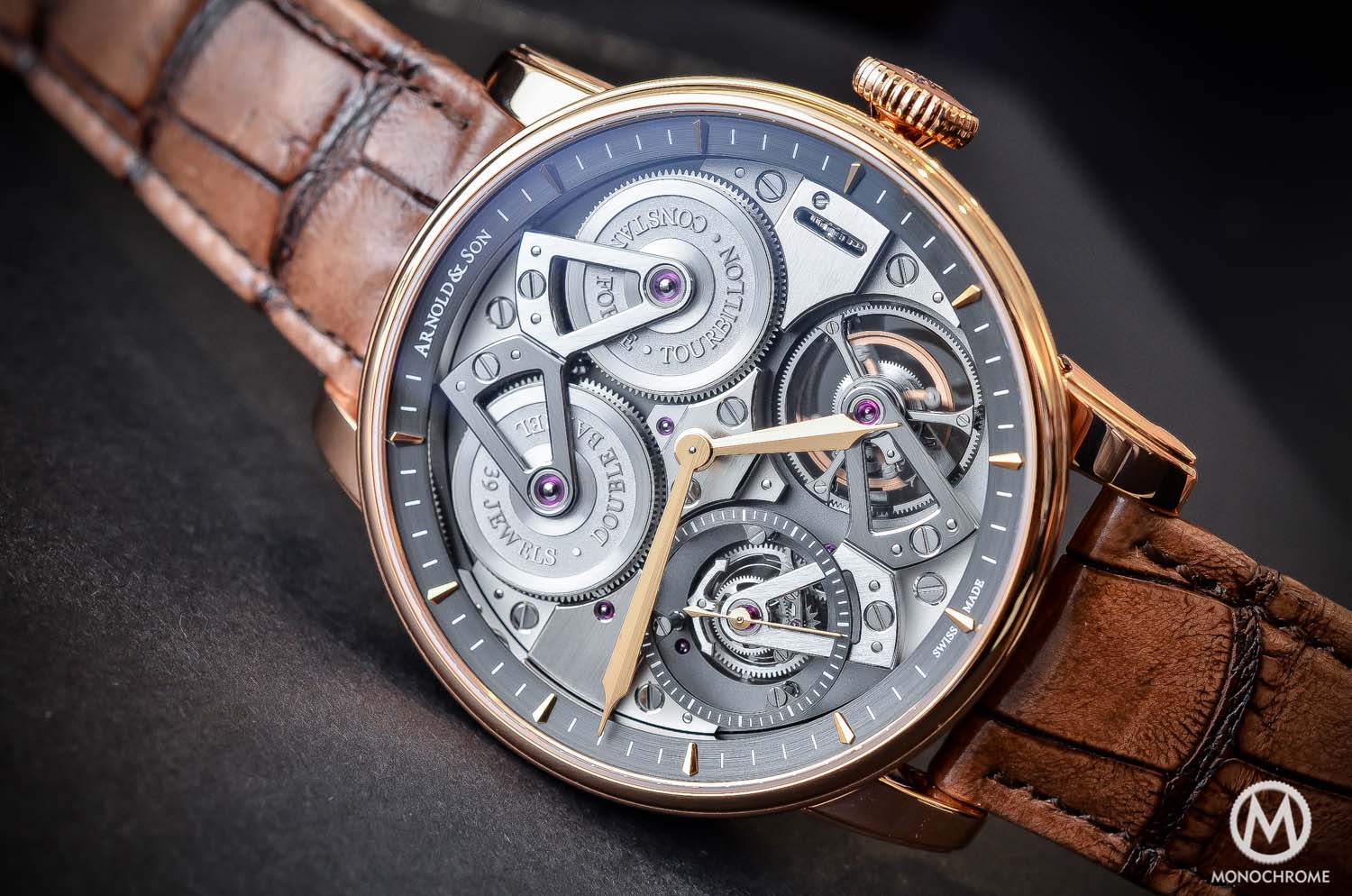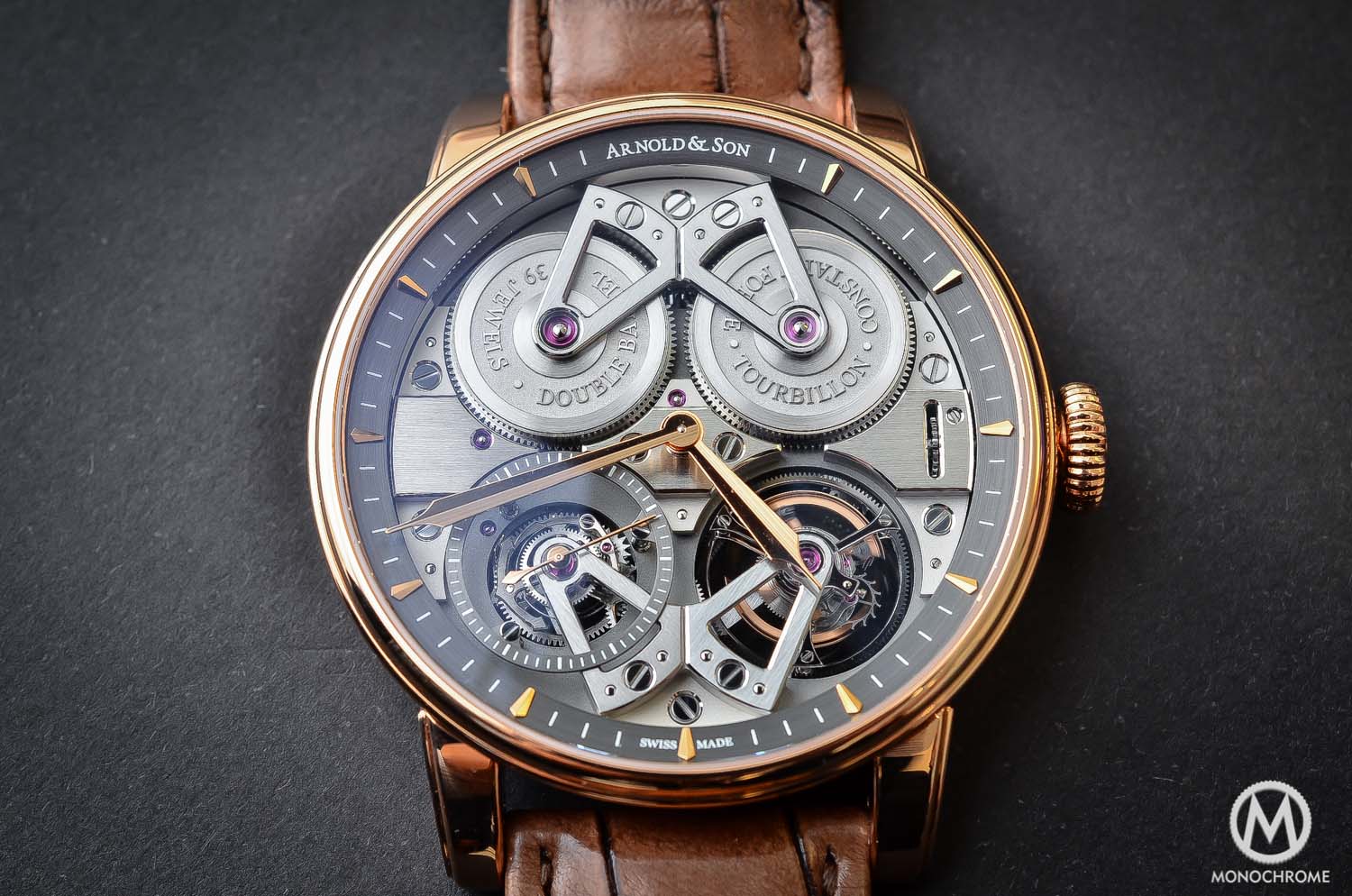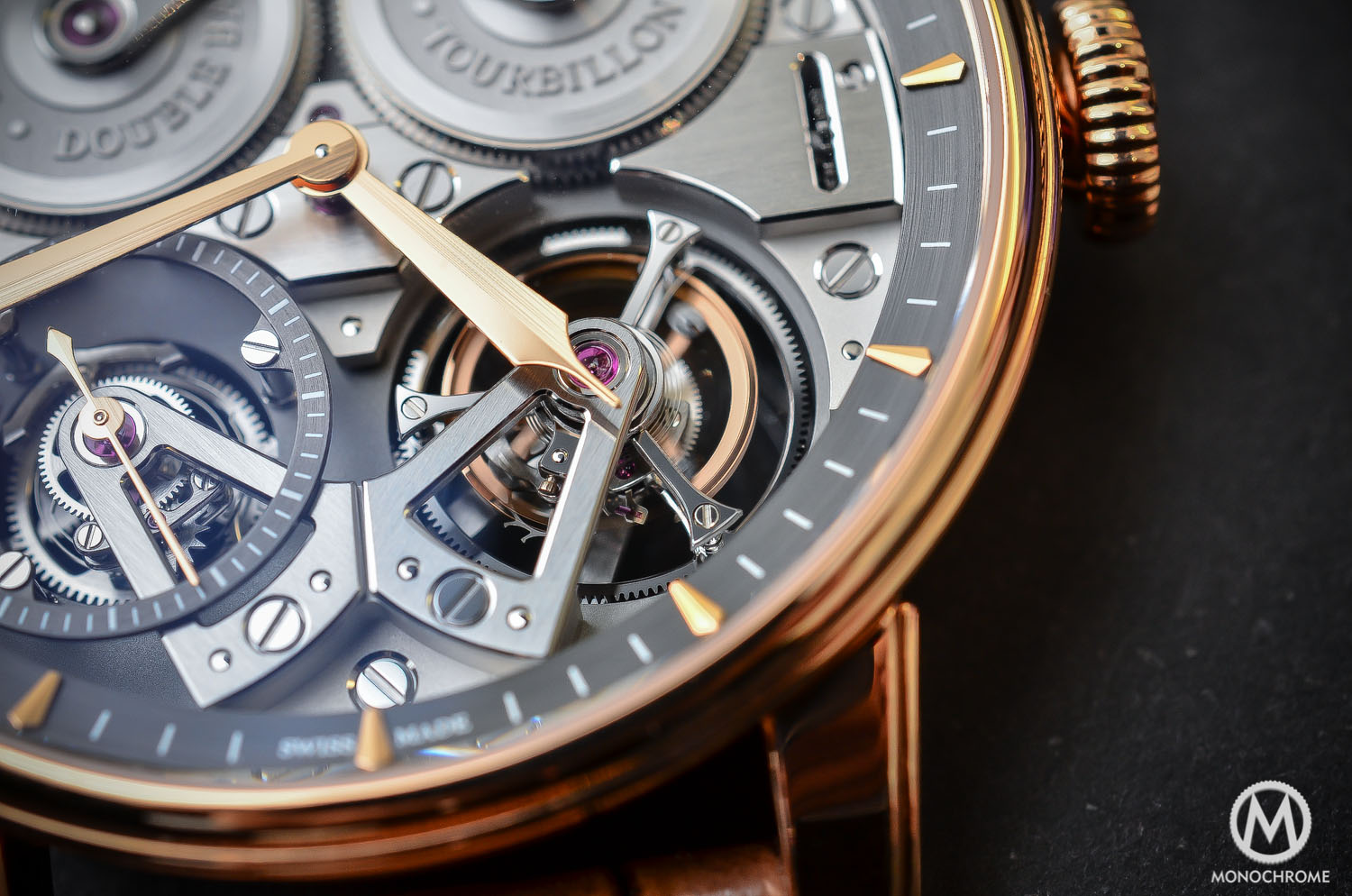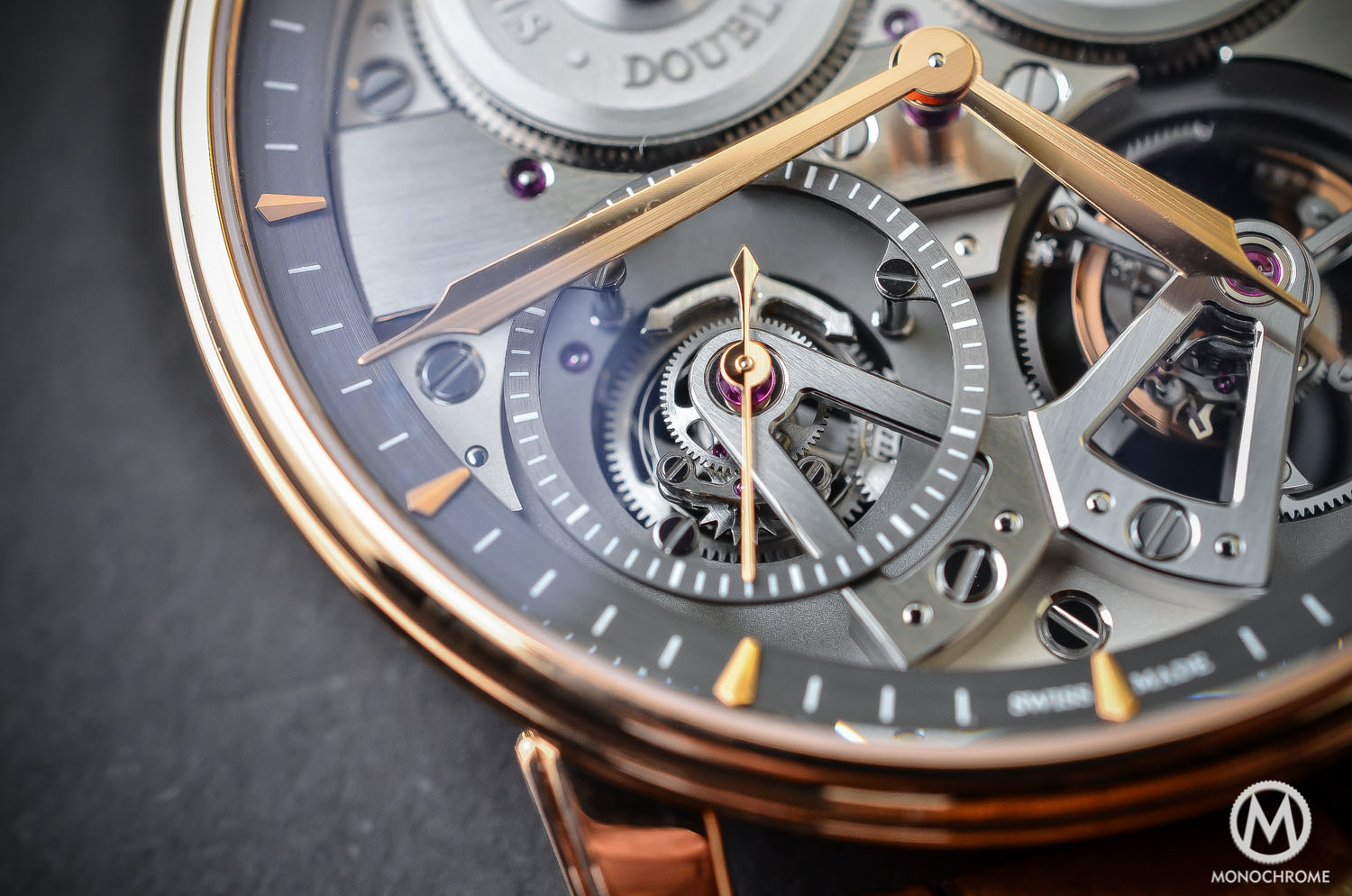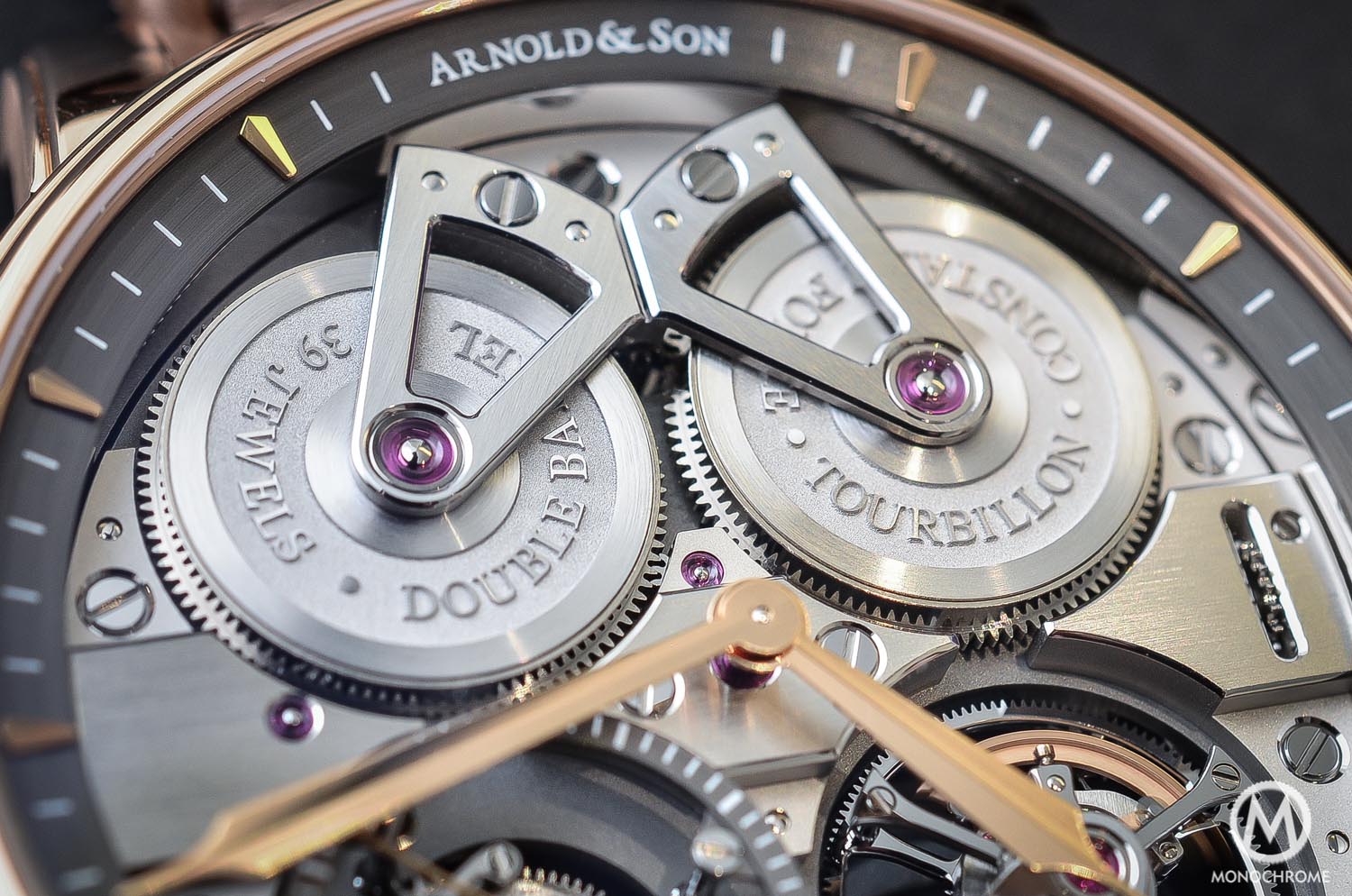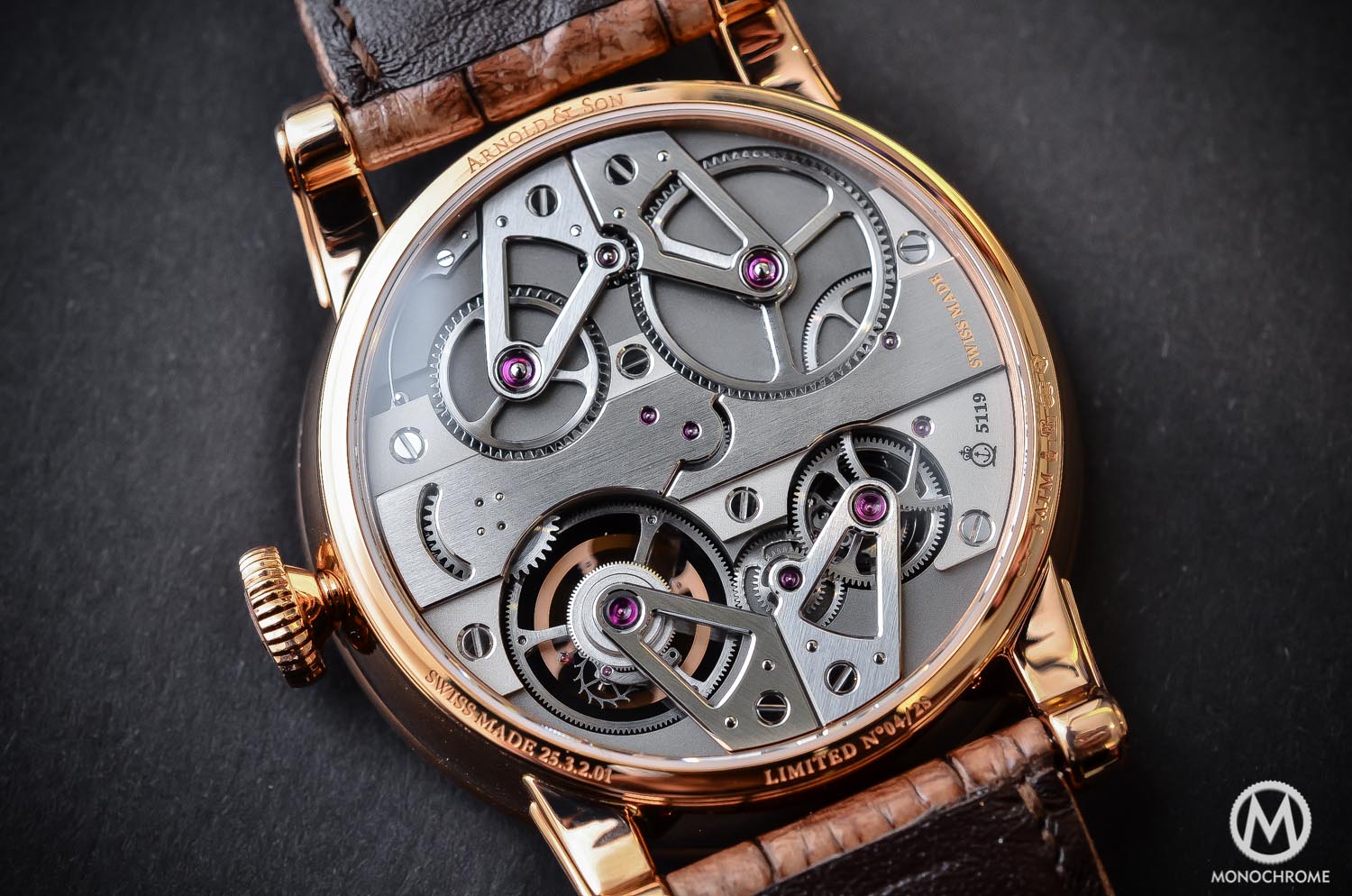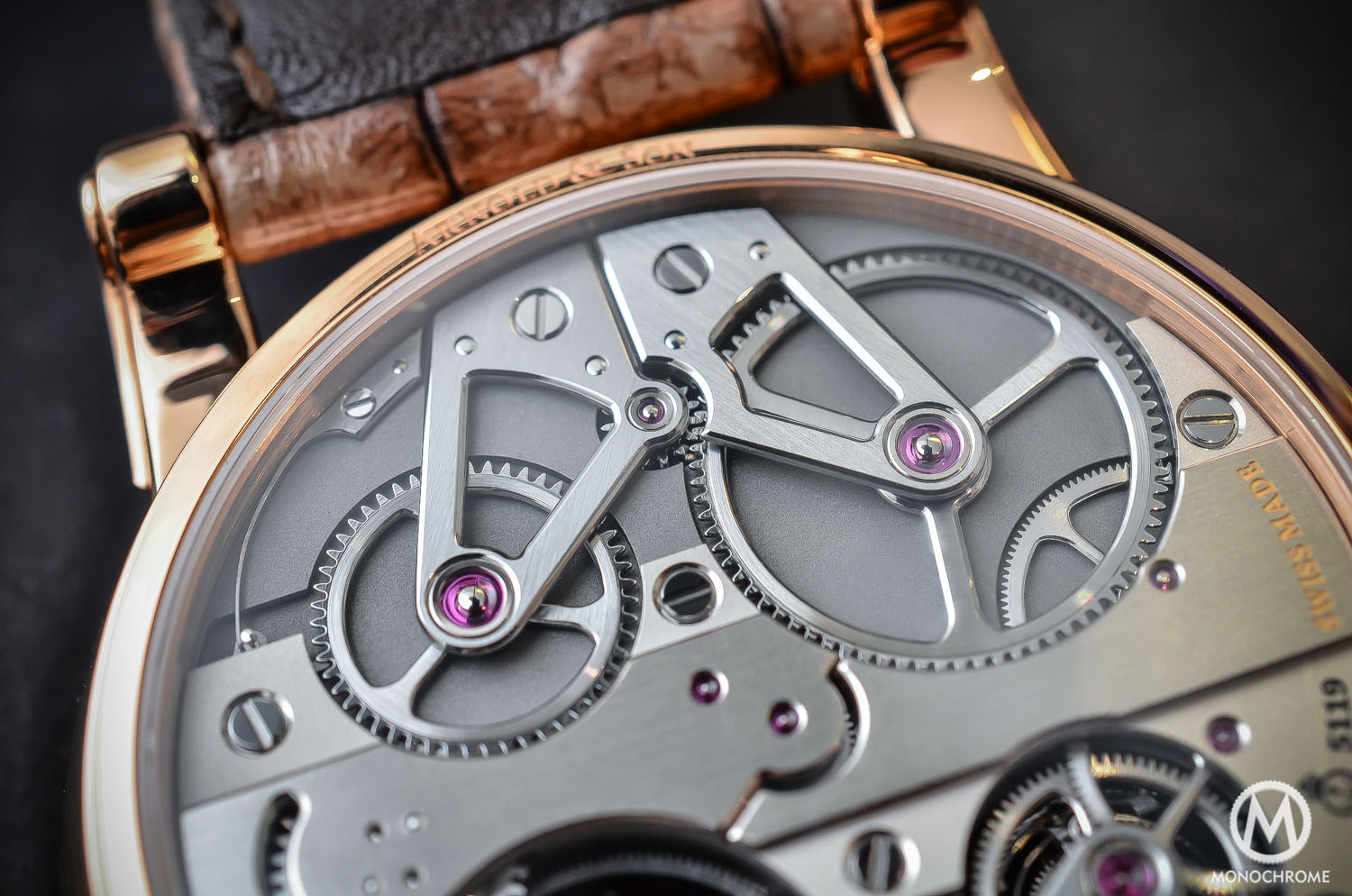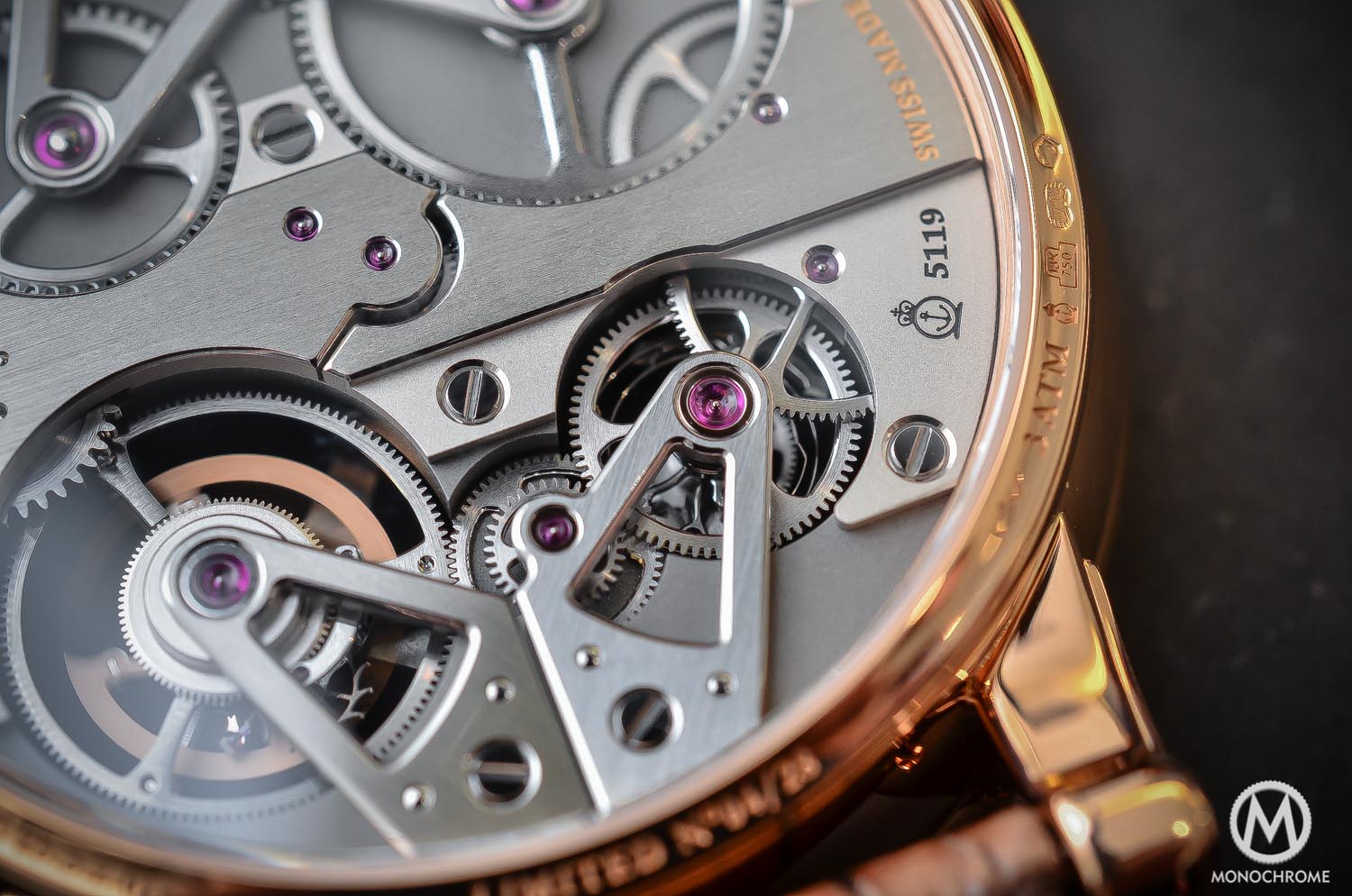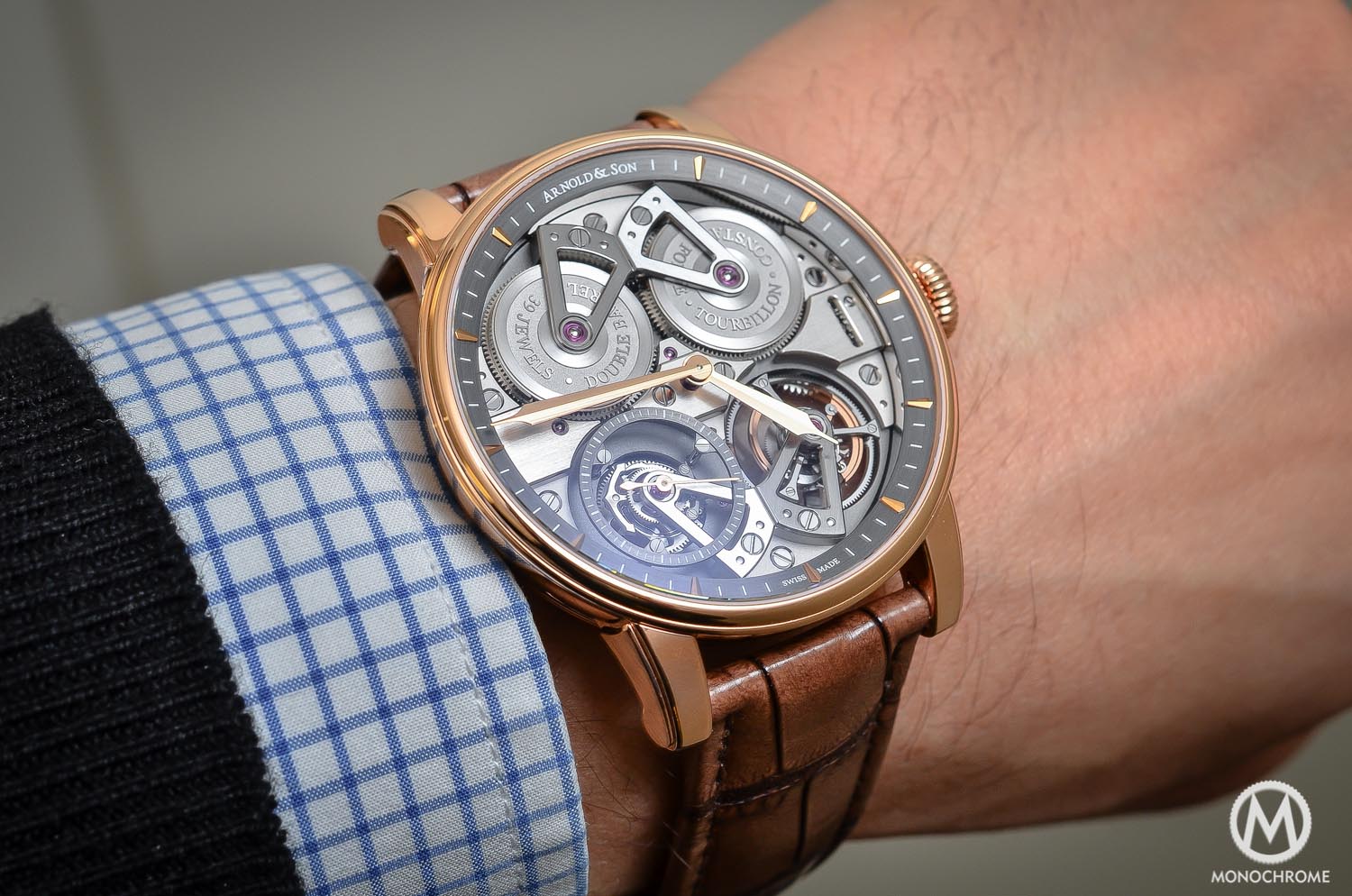Arnold and Son Constant Force Tourbillon – Review with technical explanations (live photos, specs & price)
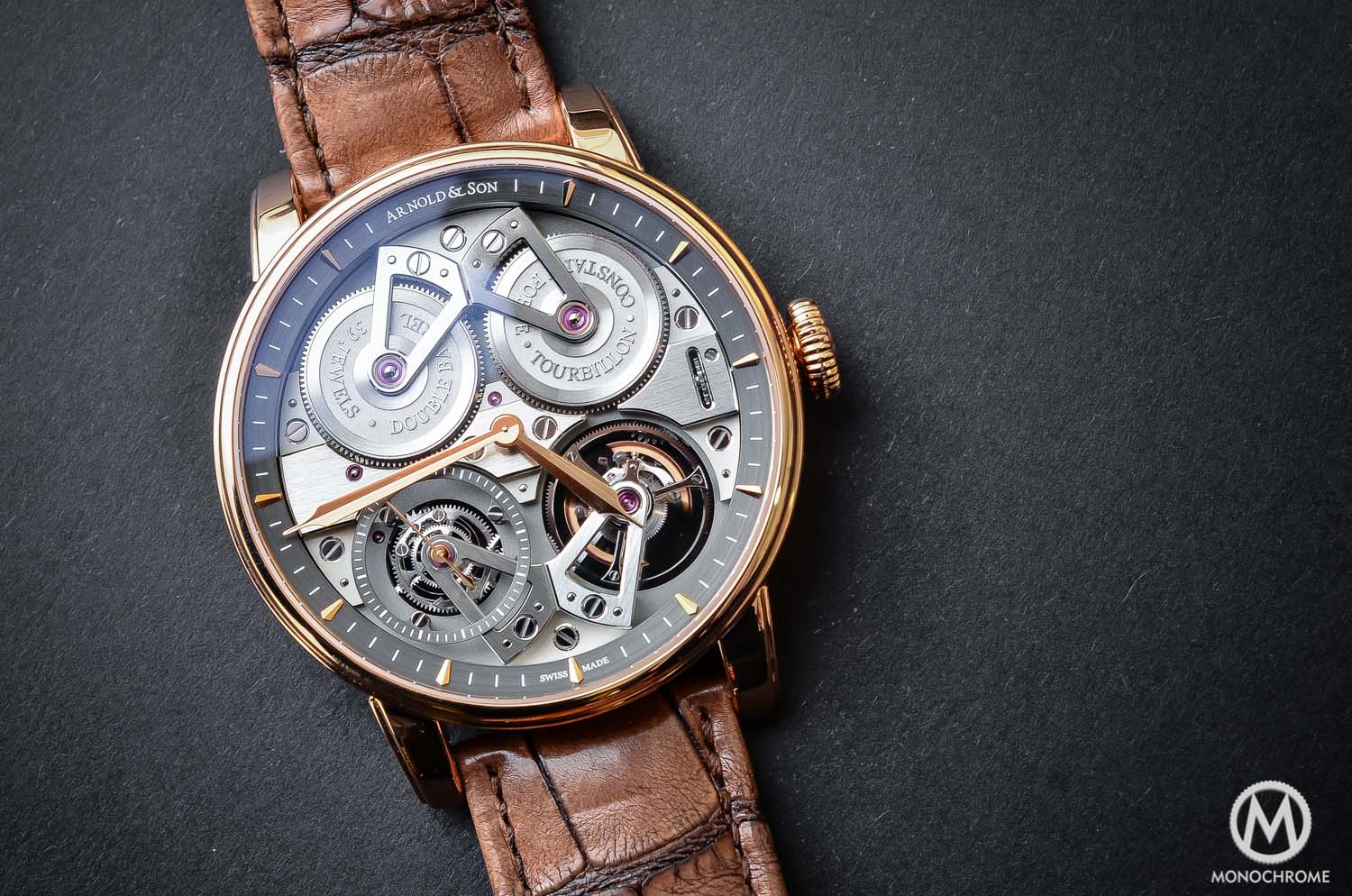
What you’ll see in this review is not “just” a watch, it’s much more, it’s a chronometry lesson that can be worn on the wrist. For a few years now, we’ve seen ultra-complicated watches with stunning displays, crazy complications and a stupendous amount of finishing. However, we do have to remember that first and most important goal of a watch is to display the time with the highest precision possible. Indeed, before being able to calculate a leap year, a perpetual calendar has to be precise in timekeeping. This path for accuracy is sometimes a bit forgotten, however Arnold and Son bring us a “back-to-basic” watch, which the single and only goal is to display the time (and nothing else) in the most precise (and stunning) way. Don’t expect any displayed complications but expect this watch to be extremely complicated. Hands-on Review of the Arnold and Son Constant Force Tourbillon.
In a recent article, we explained the importance of chronometry tests and the accuracy that some brands strived for. This path for advanced precision was, for decades, THE most important field of research for watchmakers. Complications, like the perpetual calendar, the chronograph or the minute repeater were already mastered. Of course, they can always be improved or become technically more impressive but in the case of chronometry, there’s a tangible goal to achieve: to have a minimal deviation, and to be as close as possible from the mythical +/- 0 seconds per day. You can always improve a complication by making it simpler or more complicated, by improving its easiness of use or by making it more reliable. However, this is not quantifiable. In the case of accuracy, there are numbers to verify – and that makes the story quite interesting.
The thing is that, since the re-birth of mechanical watches in the 1990s and the presence of extremely precise quartz watches, precision seems to be a second class field of research – why try to fight against electronic watches that can’t be defeated anyway. Thus, manufactures focused mainly on making people dream in front of the display rather than on trying to improve a watch’ accurancy – something that simply isn’t very sexy (except for a few collectors who are very interested in chronometry.) However, some brands are making a U-turn when it comes to chronometry, while implementing incredible solutions and sometimes even sexy ones. It is the case for Girard-Perregaux and Ulysse Nardin with their constant-force escapements (the GP Constant Escapement and the UN Anchor Tourbillon), Greubel Forsey with the double or quadruple tourbillons or FP Journe with a mix of several concepts in the Chronomètre Optimum. It’s now time for Arnold and Son to come with their own vision of a chronometry-oriented watch – and clearly, this is a also a very sexy solution.
At first, the Arnold and Son Constant Force Tourbillon seems to be a very complicated watch. Then, you look back at it and you’ll discover that it is actually (in terms of display) a basic watch: 3-hands (hours and minutes in the center and a small second) and that’s all. No calendar, no strange way to tell the time, no minute repeater or double-rattrapante chronograph… nothing else than the time. And then you sit down and you start looking closely at what you have in front of you and you discover that your first impression was the right one. The Arnold and Son Constant Force Tourbillon is indeed an extremely complicated watch, not in its display but in the way the movement drives these (only) 3 hands. It dedicated to one thing and one thing only: being precise at an instant of time, in all positions and all over the entire length of the power reserve. Every single artifice is made to improve the accuracy and the chronometry. Period! The second blast comes from the construction of the movement that has been thought to be not only efficient but also elegant and superbly balanced.
Besides the indication of time, there are actually 4 complications that can be seen on this Arnold and Son Constant Force Tourbillon – and then again, the only goal is to improve the accuracy, and this on the entire length of the power reserve. First, we have a double barrel (in series, not in parallel), then a constant force device, a one-minute tourbillon and finally a dead-beat second (a “seconde morte” or what Arnold and Son calls a True Beat Second).
The tourbillon
The tourbillon is a specific type of escapement developed during the end of the 18th century and patented by Abraham Louis Breguet in 1801. At that time, both marine chronometers, clocks and pocket watches had the same issue: they were having a static position (for instance pocket watches were worn inside the pocket of a vest and then, they were spending most of their time in an upright position). The main issue is that gravity has a effect on the regulator of a watch, like on every single thing placed on Earth. The rate of watches was negatively influenced by the Earth’s gravitational force, in particular the balance whose oscillations were fundamental to the accuracy of the movement. In order to prevent such fluctuations, Abraham-Louis Breguet had the idea to enclose the regulating organ of the watch (the balance, balance spring and escapement) in a tiny cage rotating on itself and typically completing a revolution in one minute. This allows the regulating organ to successively adopt all vertical positions, thanks to which errors of rate cancel each other out.
The utility of a tourbillon is quite debatable nowadays, with wristwatches that follow the movements of the wearer, thus rarely being placed in static position. This is true when the watch is worn, but not when then watch is standing on your nightstand or in your safe. The importance of a tourbillon remains relative for sure, however, Greubel Forsey demonstrated the utility of a watch equipped with such a device, by winning the 2011 International Chronometry Competition (with an incredibly high score).
The Arnold and Son Constant Force Tourbillon is equipped with a one-minute tourbillon, which is also quite specific in its construction. The balance is not made from a full circle of metal but instead takes the shape of two arches, to make the balance wheel lighter, more balanced and more aerodynamic. This has of course very minor influence but then again, all these small details show the intense work done by Arnold and Son.
The constant-force device (or remontoire)
In the case of the Arnold and Son Constant Force Tourbillon, this tourbillon regulator isn’t directly linked to the gear train but the delivery of torque is controlled by a specific mechanism that aims to keep the supply of energy to the escapement steady. Let’s first state the issue. The energy of a watch is provided by a main spring, a long and rather strong spring (relatively speaking and considering the size of a watch of course) that is wound and that will then unwind to deliver some energy to the gear train and keep the watch running for a specific time (the so-called power reserve). Unlike a car that is loaded with gasoline, a watch is loaded with torque. Main issue: the main spring(s) of a watch tends to react like every kind of spring, meaning that it has more torque when fully wound, and less when it’s almost unwound. That also means that a fully wound main spring delivers more torque to the gear train and then to the escapement, and an almost unwound main spring provides the escapement with less energy.
This fluctuation of energy has a negative influence on the chronometric performance of that watch, that could potentially better run when fully wound than when almost unwound (that’s also the reason why it is recommended to wind a watch regularly). This situation is quite difficult for a watchmaker that needs to regulate a watch and its regulating organ, considering that the torque transmitted to the escapement is not always the same. The dream of watchmakers is of course the so-called constant force, meaning that regardless the winding of the main spring, the level of torque remains steady. A proper 100% constant force remains unfortunately a utopia, however several devices allow being extremely close to this engineer’s dream.
The solution chose by Arnold and Son for the Constant Force Tourbillon is a so-called remontoire (something also used by FP Journe in the Chronomètre Optimum and in the Tourbillon Souverain). This is a small spring, which is being charge during one second and that releases its energy directly to the escapement. This remontoire will always release the same amount of energy, no matter if the main spring is fully loaded and has a lot of torque, or whether the main spring is almost unwound. When the power from the mainspring drops below that required to charge the small spring of the constant force mechanism, the movement stops rather than running at lower precision.
The dead-beat second
This complication is the result of the remontoire. The small second is located just over this constant-force mechanism. As the remontoire delivers its energy once every second, it was easy to implement a seconde-morte in the Arnold and Son Constant Force Tourbillon. This complication has no real influence on the precision of the watch but instead on the precision of the display, as the watch will always indicate the exact second – The second hand of almost every mechanical watch makes tiny jumps, usually between 5 and 10 per second (depending on the beat rate). That’s why it looks as if the second hand rotates smoothly around the dial in one minute. Here, the hand makes small jumps once per second and points directly the index on the circular track.
The double main spring (in series)
The Arnold and Son Constant Force Tourbillon isn’t equipped with one but two main springs, that you can see located on the upper half of the dial. We told you, a spring tends to deliver more torque when fully wound than when almost unwound. This issue gets even worse with larger springs. The larger the spring, the more unsteady the delivery of torque is. To compensate this problem, watchmaker that are looking for a longer power reserve tend to use two smaller main springs rather than one large.
Here, Arnold & Son brings 2 barrels that are working in series and not in parallel. A first main spring will unwound and deliver its torque. Once about to stop, the second main spring will take over and deliver its torque until the end of the power reserve. This will minimize the torque delivered to the gear train and thus the frictions. Furthermore and even if there’s a constant force mechanism, this double main spring will help the work of this remontoire by already smoothing the torque over the entire power reserve.
The Arnold and Son Constant Force Tourbillon – design
Well, all of this is very interesting but it could lose its point if the watch itself was ugly… which clearly is not the case. The strength this Constant Force Tourbillon is clearly the way all these mechanisms are placed on the top of the watch, giving a clear view on the way these specific features work together. The dial is not properly skeletonized and instead you have a movement that is mounted upside-down and arranged in an extremely balanced way. Everything is perfectly symmetrical and held in place by the same 4 triangular bridges, the two barrel giving echo to the tourbillon and to the remontoire.
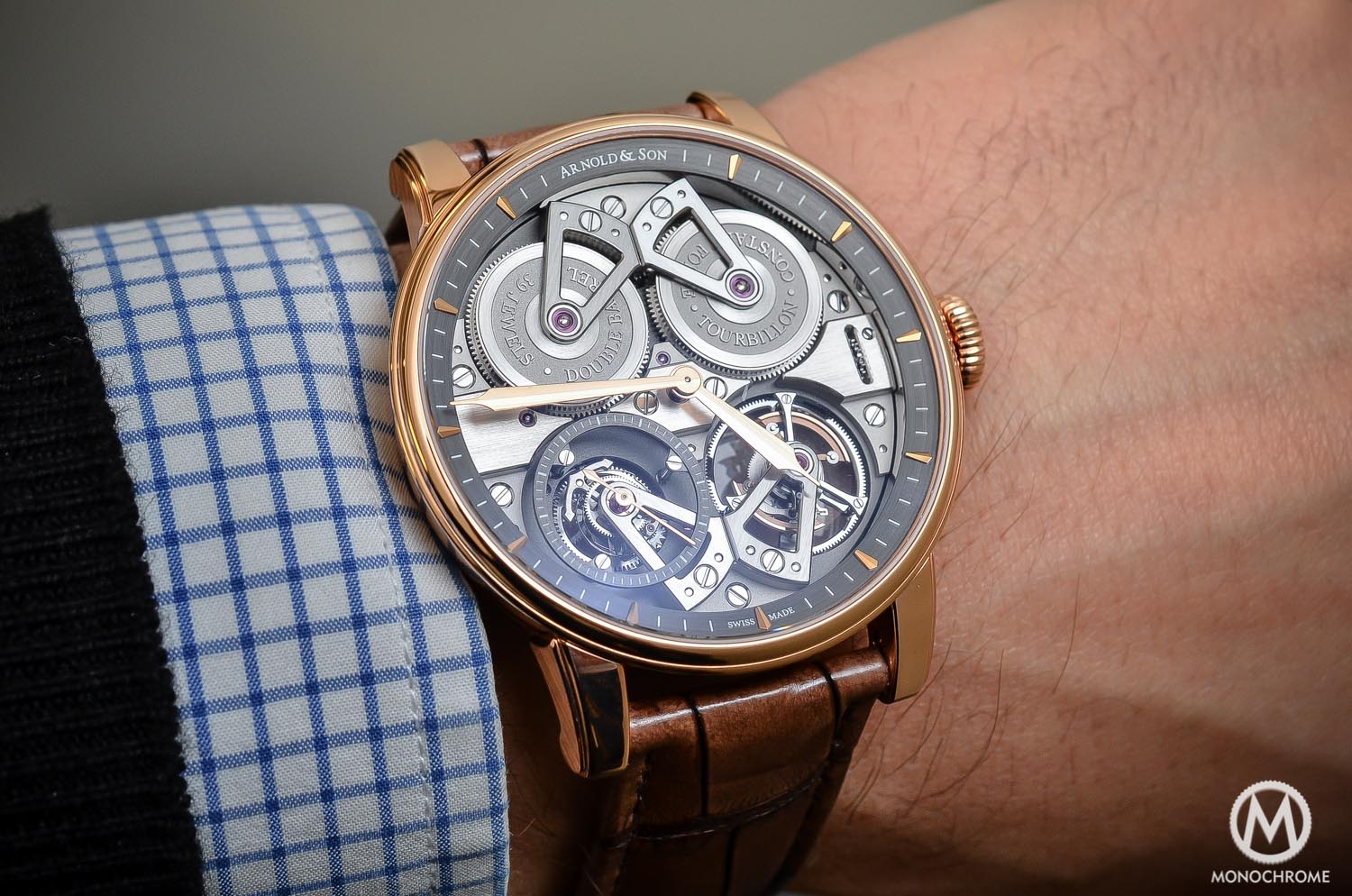 Then you have the movement. Its architecture on the back is almost the same as the front, with the 4 main modules visible. The finishing of this movement is impressive, both on the front-side and on the back-side. The nickel-silver main-plate is NAC grey treated and all the steel parts (bridges) are painstakingly finished: hand-chamfered bridges with polished edges and brushed surfaces, screwed gold chatons, screws with bevelled and mirror-polished head. The tourbillon cage is mirror-polished with hand-chamfered polished edges and circular satin-finished surfaces. One regret: Arnold and Son could have pushed one step further by having internal and sharp angles – but we’re picky here. The movement has 39 jewels, a diameter of 36.8 mm, a thickness of 6 mm (quite reasonable considering the level of complication), a power reserve of 90 hours and ticks at 21,600 vibrations/h.
Then you have the movement. Its architecture on the back is almost the same as the front, with the 4 main modules visible. The finishing of this movement is impressive, both on the front-side and on the back-side. The nickel-silver main-plate is NAC grey treated and all the steel parts (bridges) are painstakingly finished: hand-chamfered bridges with polished edges and brushed surfaces, screwed gold chatons, screws with bevelled and mirror-polished head. The tourbillon cage is mirror-polished with hand-chamfered polished edges and circular satin-finished surfaces. One regret: Arnold and Son could have pushed one step further by having internal and sharp angles – but we’re picky here. The movement has 39 jewels, a diameter of 36.8 mm, a thickness of 6 mm (quite reasonable considering the level of complication), a power reserve of 90 hours and ticks at 21,600 vibrations/h.
The Arnold and Son Constant Force Tourbillon comes in a 18k red gold case that measure 46mm. It is a large watch on the wrist for sure however; comfort is not the main goal of this watch, which has to be seen more as a demonstration of high-end horology than a commercially-oriented piece. It’s a showcase-watch, not a tool-watch.
Concluding words
Back on the main topic – and the main goal of this watch: accuracy. Technically and on paper, there’s no doubt to have regarding the possibly very high accuracy of the Arnold and Son Constant Force Tourbillon. It uses 3 known concepts that proved to be efficient. The tourbillon will do his job, the remontoire will provide a (theoretically) constant-force and the double barrel will help to improve the steadiness of the torque. All together, these 3 complications will have a very positive effect on the accuracy.
Now there are two questions. What about this watch on field, in the real life? We didn’t have the chance to properly test the Arnold and Son Constant Force Tourbillon (with the required material) so we can’t actually state on the effectiveness of these complications. Then, like always in high-end watchmaking, there is the intervention of humans and a watch like this needs to be carefully regulated and adjusted. Just to say that such a movement requires the best watchmakers to be sure to exploit all the capacities of such complications. Without doubting of the ability of Arnold & Son to do so, the human factor will always be part of the equation. Anyway, this watch is a very impressive piece and a nice tribute to ancient horology, when accuracy was the main goal. And we love it here at Monochrome-Watches.
Limited Edition of 28 pieces. Price: 197,500 USD. www.arnoldandson.com.

